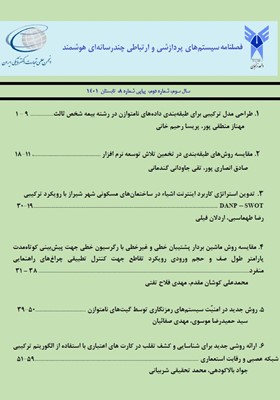مقایسه روش ماشین بردار پشتیبان خطی و غیرخطی با رگرسیون خطی جهت پیشبینی کوتاهمدت پارامتر طول صف و حجم ورودی رویکرد تقاطع جهت کنترل تطبیقی چراغهای راهنمایی منفرد
محورهای موضوعی : پردازش چند رسانه ای، سیستمهای ارتباطی، سیستمهای هوشمندمحمد علی کوشان مقدم 1 , مهدی فلاح تفتی 2 *
1 - کارشناسی ارشد، دانشکده مهندسی عمران، دانشگاه یزد، یزد، ایران
2 - دانشیار، دانشکده مهندسی عمران، دانشگاه یزد، یزد، ایران
کلید واژه: پیشبینی ترافیک, چراغ راهنمایی تطبیقی, طول صف, رگرسیون بردار پشتیبان, حجم ورودی به رویکرد تقاطع,
چکیده مقاله :
این مطالعه به منظور توسعه سیستمهای کنترل چراغ راهنمایی با رویکرد تطبیقی جهت کنترل بهتر ترافیک در تقاطعات صورت گرفته است. در این رویکرد اگر از دادههای پیشبینی شده مربوط به سیکلهای آینده به منظور بهینهسازی زمانبندی استفاده گردد، باعث کنترل ترافیک در موارد پیشبینی نشده و مدیریت آن قبل از رسیدن به سیکل مورد نظر میشود. در این راستا از روش رگرسیون بردار پشتیبان به صورت خطی و غیرخطی برای پیشبینی پارامتر طول صف و حجم ورودی به یک رویکرد به عنوان دو متغیر اصلی مورد نیاز در فرآیند کنترل تطبیقی استفاده شد. برای داشتن داده کافی جهت ایجاد چنین مدلی به آماربرداری از دو تقاطع شهر یزد و شبیهسازی آنها در نرمافزار شبیهساز ایمسان پرداخته شد. سپس این تقاطعها برای شرایط موجود کالیبره و اعتبارسنجی گردیدند. نتایج دقت پیشبینی به روشهای پیشنهادی استخراج شده و با روش رگرسیون خطی مقایسه گردید. نتایج نشان دادند که رگرسیون بردار پشتیبان به صورت غیرخطی دارای عملکرد بهتری نسبت به هر دوی مدل پیشنهادی در حالت خطی و رگرسیون خطی است. دو روش رگرسیون بردار پشتیبان به صورت خطی و رگرسیون خطی عملکردی مشابه نشان دادند.
IntroductionThis study was carried out in line with the development of adaptive traffic signal control systems to provide a better traffic control at intersections. In this approach, if the predicted data related to the future cycles are used to optimize the upcoming schedule, it will control the traffic in unforeseen cases and manage it before reaching the forthcoming cycles. In order to have enough data to create such a model, the required data from two intersections in Yazd city were collected and these intersections were simulated using AIMSUN software. Then these intersections were calibrated and validated for existing conditions. The prediction accuracy results were extracted by the proposed methods and compared with the linear regression method. RMSE, MAE and GEH errors were used to compare the methods.Method: The predicted queue length and arrival volume parameters for any entry approach of itersections are major variables required during the adaptive signal control process, Hence, Linear and Non-linear Support Vector Regression Methods combined with the time series method were used to predict these parameters. For comparison of the performance of these models with a conventional model, Linear Regression models were also developed for the prediction of these parameters.ResultsFor the developed model based on combined Linear Support Vector Regression and the time series methods, the number of optimal previous cycle data used in the model was measured as 6 and 2 previous data cycles for predicting the arrival volume at Pajuhesh and Seyed Hassan Nasrollah intersections, respectively. The optimal number of previous data used in the model was measured as 9 and 11 previous data cycles for predicting the queue length at Pajuhesh and Seyed Hassan Nasrollah intersections, respectively. Also, using the combined Non-Linear Support Vector Regression and the time series methods, the number of optimal previous data cycles was obtained as 8 and 2 cycles in predicting the arrival volume at Pajuhesh and Seyed Hassan Nasrollah intersections, and the number of optimal previous data cycles was obtained as 7 and 7 cycles in predicting the queue length at Pajuhesh and Seyed Hassan Nasrollah intersections.Discussion: The results of RMSE, MAE and GEH measures were used to compare the performance of the developed models with the real data. This comparison indicated that the model based on the combined Non-Linear Support Vector Regression and time series methods, has produced the best performance in predicting traffic arrival volume than the other aforementioned models. However, in terms of predicting the queue length, this model produced a better performance than the combined Linear Support Vector Regression at only one of the intersections. The Linear Regression model produced the weakest performance in all comparisons. Thus, it can be concluded that the combined Support Vector Regression and time series methods are appropriate tools in predicting traffic parameters in these situations.
_||_

